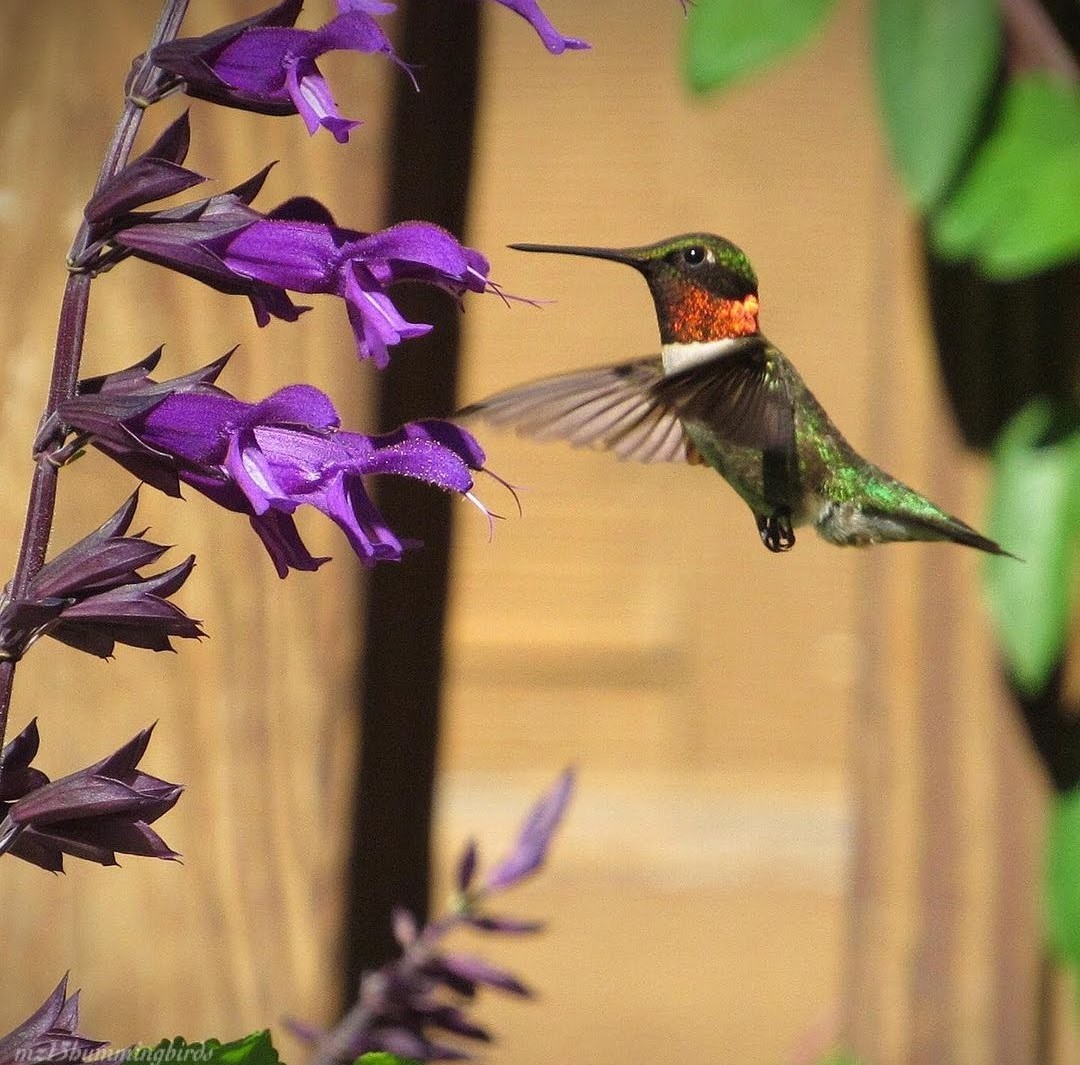This post contains affiliate links.
What species of hummingbirds are found in Indiana?
- There are 8 species of hummingbirds found in Indiana
- Year-round Natives: Ruby-throated.
- Seasonal: Allen’s, Rufous.
- Rare: Anna’s, Black-chinned, Broad-tailed, Calliope, Green-violetears also known as Mexican-violetears.
Indiana is known as the Hoosier State and is home to one species of hummingbirds out of the five species. The hummingbird season in Indiana peaks during spring migration in the first week of April and by the end of September they begin their fall migration south.
The climate of Indiana is humid continental to a humid subtropical climate. It has hot, humid and wet summers with cold bitter snowy winters. The topography consists of flat rugged plains and hilly terrain, caves, ridges and waterfalls.
There are 3 categories of hummingbirds found in Indiana.
Year-round/Native Hummingbirds:
This classification is defined as hummingbirds that reside and do not migrate in Indiana 365 days a year as a group.
- Ruby-throated
Seasonal Hummingbirds
These hummingbirds reside in Indiana temporarily as part of their migratory pattern. A group of these species spend the entire spring, summer and fall in Indiana while others of this migratory group may travel to more northern states during the summer.
- Allen’s
- Rufous
Rare/Vagrant Hummingbirds
This classification is defined by hummingbirds residing in a group outside of their normal geographic range. Not only do these species of hummingbirds have a wide variety of specific geographic ranges, they are also known to sometimes interbreed with each other, creating hybrids.
- Anna’s
- Black-chinned
- Broad-tailed
- Calliope
- Green-violetears also known as Mexican-violetears
Note: Hummingbirds are listed in alphabetical order.
Read on to find out more about each of these hummingbird species as well as where and when they can be found in Indiana.
Year-round/Native Hummingbirds
RUBY-THROATED HUMMINGBIRD – (Archilochus colubris)
Conservation Status: Least concerned
Kingdom: Animalia
Phylum: Chordata
Class: Aves
Order: Apodiformes
Family: Trochilidae
Genus: Archilochus
Species: A. colubris
The Ruby-throated hummingbird’s scientific name originated from Carl Linnaeus, a Swedish botanist, who first listed this scientific classification as “Trochilus colubris”. It’s name changed over a hundred years later and was reclassified by Ludwig Reichenbach, a German botanist to “Archilochus colubris”, which is its current scientific name, meaning “top thief” or “sky spirit/sun-god bird”.
Ruby-throated hummingbirds are Year-round Natives and are the most commonly seen hummingbird in Indiana. While most Ruby-throated hummingbirds are seen year round, some Ruby-throated hummingbirds prefer to migrate south to winter in Mexico.
According to the Indiana Department of Natural Resources, the Ruby-throated hummingbird is the most common hummingbird to Indiana State Parks.
Male Ruby-throated hummingbirds have a striking iridescent blood-red gorget, stopping at the neckline. He is identified with a dull metallic green topside, a light gray underbelly and black wings. The Ruby-throated hummingbird is a smaller species of hummingbirds weighing less than 4.5 grams or 2 U.S. dimes and is 2.8 to 3.3 inches in length. Their lifespan is approximately 5 years.
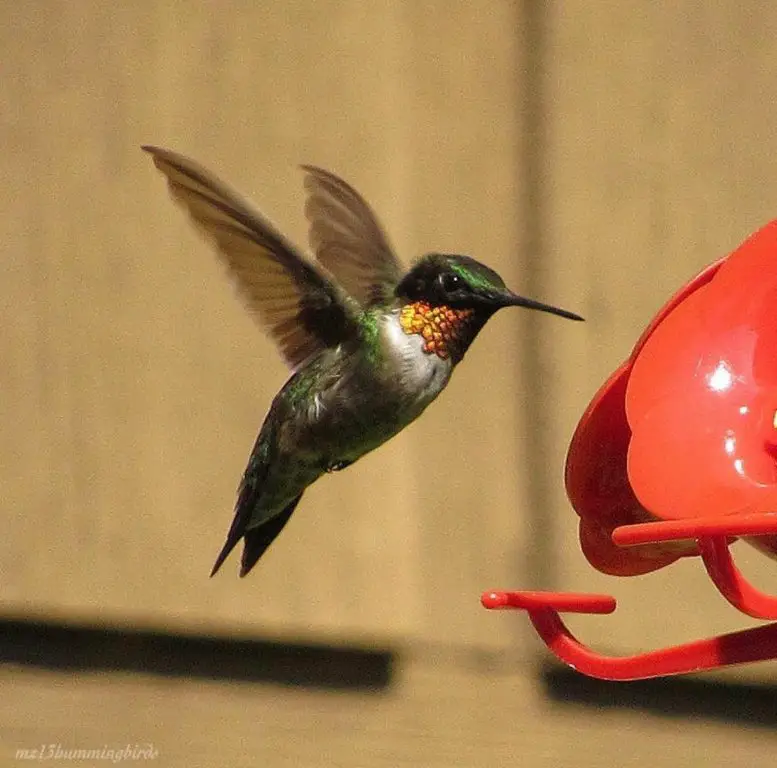
Photo by: mz13hummingbirds
Taken: Indiana
Female Ruby-throated hummingbirds have a white throat with some light stippling and are typically larger than the males. The oldest female Ruby-throated hummingbird has been recorded at 9 years, almost double that of the male. However, the average lifespan of a Ruby-throated hummingbird is approximately 3-5 years.
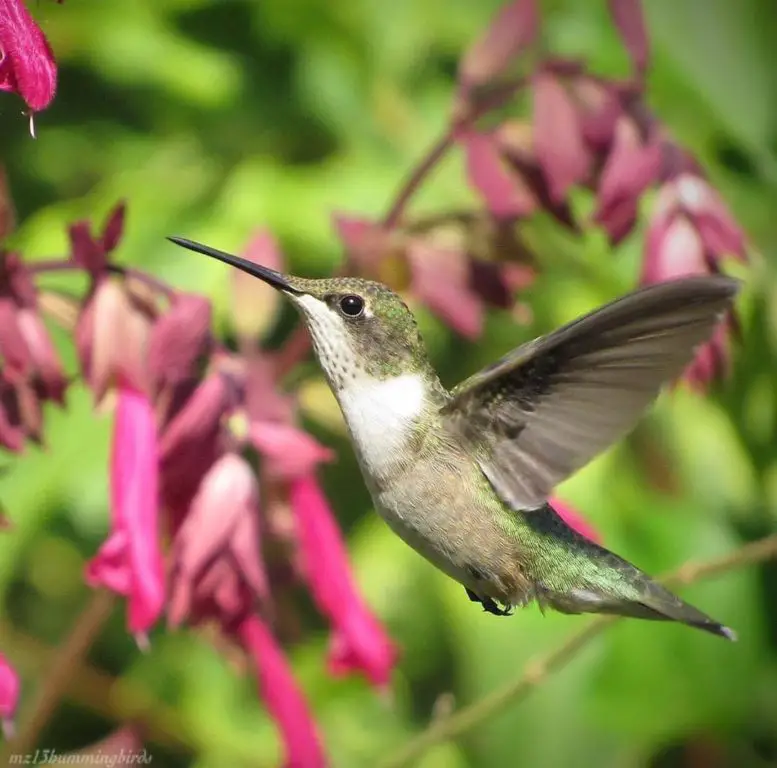
Photo by: mz13hummingbirds
Taken: Indiana

Photo by: mz13hummingbirds
Taken: Indiana
Flower: Zinnia ‘Purple Prince’
Juvenile male and female Ruby-throated hummingbirds during their initial stages of life resemble their mother exhibiting a white throat with light stippling.

Photo by: mz13hummingbirds
Taken: Indiana
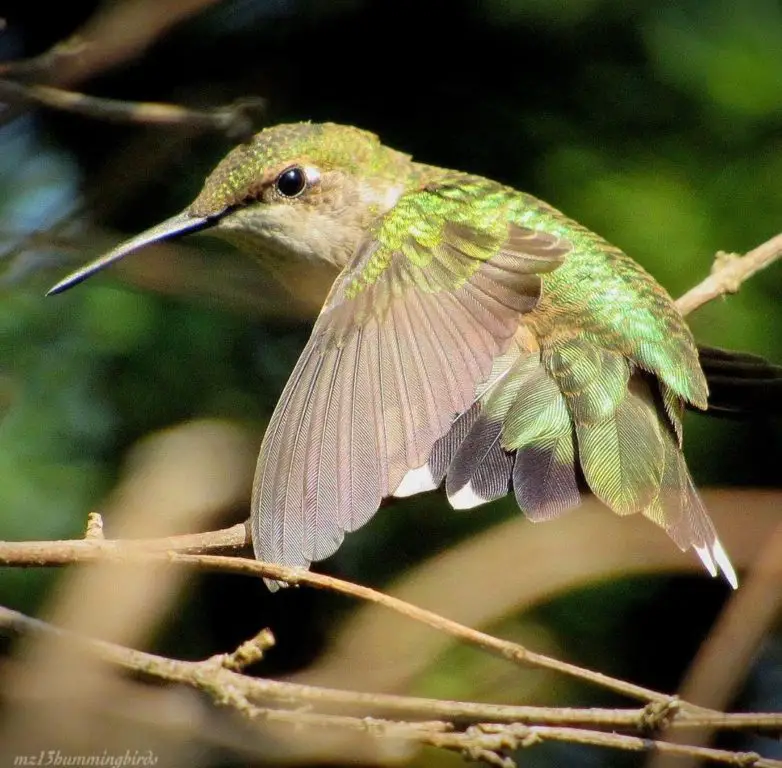
Photo by: mz13hummingbirds
Taken: Indiana
Note in the picture below the newly white fluffy down feathers on this baby Ruby-throated Hummingbird’s bottom. Also notice the nice fat reserves this baby hummingbird has accumulated by being fed by its diligent mother hummingbird which will sustain it through adolescence.
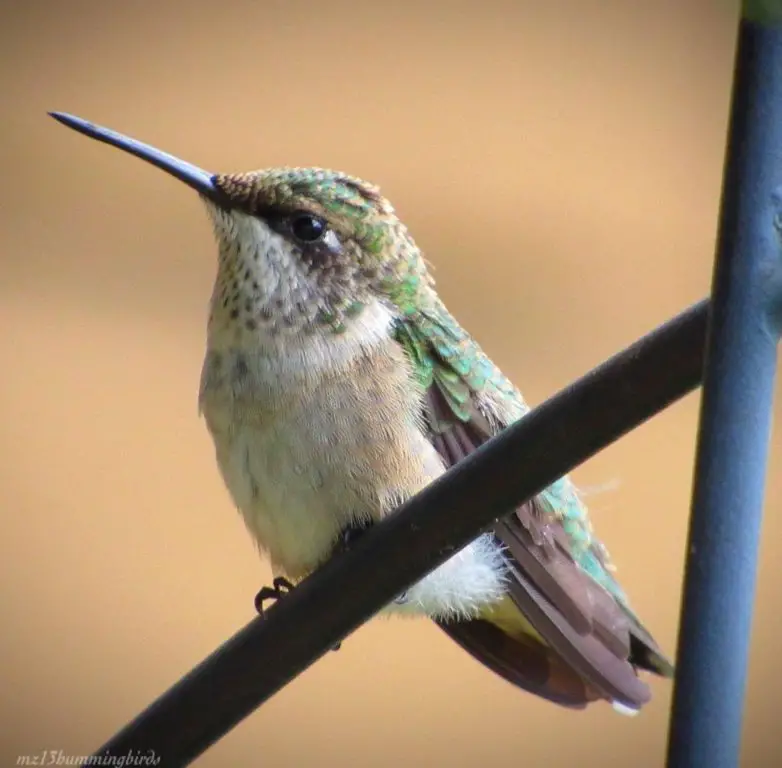
Photo by: mz13hummingbirds
Taken: Indiana
As the males mature, they begin to display a few specks of color near their neckline and eventually their bolder red throat feathers become more dominant and stately displaying a colorful gorget.
Juvenile females show a light faint grey stippling on their throat. As both sexes mature their less vivid and lighter colored plumage will begin to mature and become darker in color.
Ruby-throated hummingbirds are the only species that breed in Indiana and nest east of the Mississippi River. They prefer to build a nest 10-20 feet up in deciduous trees.
According to Purdue University of Forestry and Natural Resources in West Lafayette, Indiana, the Ruby-throated hummingbird’s nesting materials consist of down from dandelion, thistle, milkweed, portions of ferns, mosses, and young leaves.
There are two migration routes for the Ruby-throated hummingbird during the spring and fall migrations.
The first migration route is a direct but exhausting nonstop journey southwest over the Gulf of Mexico to Mexico and then down to Central America for the winter. The flight distance over the Gulf of Mexico is over 500 miles. Although this is the direct “short” route, there are numerous obstacles faced by these birds.
Some obstacles include not being able to rest, no means to refuel or eat and having to avoid the dangerous tropical Atlantic hurricanes while flying to their destination. To make matters worse, depending on how you look at it, they migrate during the dark hours of the night or are taking the “Red-eye flight”.
Researchers believe their small size makes the energy expenditure of their grueling trans-oceanic migration journey more taxing for males than for females even though they both double their body’s fat content prior to making the migration across the Gulf of Mexico.
The second migration route is over 2,000 miles, flying along the coastline outlining the Gulf of Mexico. Although this is the “long” route, it allows the opportunity to rest and refuel even though there are less food source guarantees along the way.
Scientists are unclear and continue to investigate as to why one group of birds would prefer to take one route over the other.
The migratory Ruby-throated hummingbirds during spring migration are seen in late March to early April arriving in Indiana. They remain throughout the hot summer and begin their departure south to winter in Mexico for fall migration as early as late July through the end of October.
In February they begin their migration journey back north to breed.
Ruby-throated hummingbirds prefer open woodlands and are often seen in parks, gardens, and backyards. They are solitary birds except during mating periods when they are fiercely territorial and aggressive towards hummingbirds of other species. Even though these hummingbirds have an aggressive side they can still be eaten by predators such as large invertebrates, praying mantises, orb-weaver spiders, and dragonflies.
See my article: 10 Common Things That Kill Hummingbirds
See pictures of male, female, and juvenile Ruby-throated hummingbirds here…..
Hear sounds of Ruby-throated hummingbirds here…..
Seasonal Hummingbirds
ALLEN’S HUMMINGBIRD – (Selasphorus sasin)
Conservation Status: Least concerned
Kingdom: Animalia
Phylum: Chordata
Class: Aves
Order: Apodiformes
Family: Trochilidae
Genus: Selasphorus
Species: S. sasin
The common name of Allen’s hummingbird is in commemoration of Charles Andrew Allen (1841-1930), an American collector and taxidermist.
Allen’s hummingbirds are seasonal migratory visitors to Indiana because they are seen at feeders during fall migration. They commonly reside and nest along the California coast and winter in Mexico however, some continue their migration and wander farther north into Indiana.
Sightings are seen in southern Indiana where the climate is milder, as they move farther north the winters are brutal.
Male Allen’s hummingbirds show an iridescent orange-red gorget. They are green backed with a green forehead and rust-colored flanks, rump, and tail. When their tail feathers are fanned out you can see their chocolate-colored tips. Allen’s hummingbirds are 3.3 inches to 3.5 inches in length and weigh 2-4 grams.
Females and juveniles Allen’s hummingbirds have similar coloring as the males, but lack the iridescent gorget.
Juvenile Allen’s hummingbirds are so similar in coloring and temperament to a Rufous hummingbird that they are practically indistinguishable in the field. Therefore, identification is established by range rather than appearance.
Their nesting season is perfectly timed to when the regions have the most rainfall which helps provide prolific nectar producing flowers for their offspring.
Male Allen’s hummingbirds perform a striking, quick back-and-forth courtship dance resembling the movement of a pendulum. They have one of the most complex territorial dive displays of any North American hummingbird.
See my article Hummingbird Dance: 5 Interpretive Explanations
Male and female Allen’s hummingbirds are not social birds. They do not associate with one another outside of breeding. Similar to a Rufous hummingbird, Allen’s hummingbirds are highly territorial and can be aggressive not only towards other hummingbirds but will also attack any species; even larger predatory birds such as hawks.
Their habitat consists of open woodlands, dry chaparral vegetation consisting of dense shrubs, thorny bushes and riparian wetlands.
Allen’s hummingbirds are absent at mountainous elevations above 9,000 feet due to the lack of hummingbird flowers that would otherwise serve as their nectar source.
See pictures of male, female and juvenile Allen’s hummingbirds here…..
Hear sounds of Allen’s hummingbirds here…..
RUFOUS HUMMINGBIRD – (Selasphorus rufus)
Conservation Status: Near threatened
Kingdom: Animalia
Phylum: Chordata
Class: Aves
Order: Apodiformes
Family: Trochilidae
Genus: Selasphorus
Species: S. rufous
The Rufous hummingbird gets its name from the Latin word rubrum meaning “red” that is used to describe its reddish-brown coloring. They are Seasonal migrants and are sighted just passing through the state of Indiana in November and stay as late as January.
According to Purdue University of Forestry and Natural Resources in West Lafayette Indiana, Rufous hummingbirds are observed at feeders and in local gardens during fall migration when they pass through Indiana in November.
Male Rufous hummingbirds display an iridescent orange-red gorget with rusty-colored flanks and tail. They have a white to beige underbelly and a black bill. Males can also have green plumage with specks of green color on their rustic looking backs or on the crown of their head along with chocolate brown dorsal feathers. Their size is 2.8 inches to 3.5 inches in length and weigh 3.2 grams.
Juvenile male Rufous hummingbirds have a rustic look with small iridescent orange specks of color on their throats.
Female Rufous hummingbirds are green and white with some iridescent orange feathers on their throat. Their tail is dark with white tips and an orange-red base. Female Rufous hummingbirds are slightly larger than the males in anticipation of producing offspring.
They have one of the northernmost breeding ranges of any hummingbird in the world; migrating north from Mexico to Oregon, Washington, Canada and nesting as far north as Alaska to breed during the summer months. They are polygamous and will mate with several partners in a season.
Rufous hummingbirds make the longest migrations of any bird in the world. They travel making a clockwise circuit of western America every year that is approximately 3,900 miles.
Rufous hummingbirds are highly territorial and aggressive towards other hummingbirds and animals. They are fearless and have a reputation for chasing away not only other hummingbirds but even large birds and rodents from their favorite feeders. They have been known to even attack squirrels and chipmunks that come too close to their nest.
Their flying acrobatic skills can outmaneuver all other hummingbird species, making them extremely competitive at feeders.
Rufous hummingbirds have excellent memories and have been known to investigate the location of an old hummingbird feeder years after the feeder has been removed.
During a capture and release banding operation in British Columbia, the oldest living recorded female Rufous hummingbird was 8 years and 11 months old.
See my article: 3 Reasons Why Hummingbirds Are Banded
Due to habitat loss in the Pacific Northwest, Rufous hummingbirds are listed at “near threatened” status by the IUCN red list of threatened species.
See pictures of male, female and juvenile Rufous hummingbirds here…..
Hear sounds of Rufous hummingbirds here…..
Rare/Vagrant Hummingbirds
ANNA’S HUMMINGBIRD – (Calypte anna)
Conservation Status: Least concerned
Kingdom: Animalia
Phylum: Chordata
Class: Aves
Order: Apodiformes
Family: Trochilidae
Genus: Calypte
Species: C. anna
Anna’s hummingbirds are named after Anna Massena, Duchess of Rivoli. These birds are commonly found on the west coast of the United States therefore they are identified as extremely rare when seen in Indiana, a mid western state.
In 2010, the only female Anna’s hummingbird found and identified was seen in Lake County Indiana which is located on the northwestern part of the state bordered by Illinois on the west and Michigan on the north.
Male Anna’s hummingbirds are the only hummingbird species in North America with a red crown. They are identified as mostly green, gray, and magenta in color. The males have a flashy and colorful iridescent magenta gorget and crown. Their size ranges from 3.5 inches to 4.3 inches in length and they weigh 2.4 to 4.5 grams.
The gorget on a male hummingbird is named after the protective metal piece in a suit of armor that covers the wearer’s throat to prevent injury when in battle. Since male hummingbirds are very aggressive with each other when fighting for their own territory, this name is appropriate and fitting to describe their physical attributes.
Unlike many northern temperate hummingbirds, male Anna’s hummingbirds sing during courtship (though the song is so high-pitched and squeaky, it’s hard to call it singing).
Female Anna’s hummingbirds are pale green and are not as colorful as the males. They have a distinctive pale white line over each eye which is an identifiable trait.
The Anna’s hummingbirds protect their territory with elaborate dives targeted towards predatory birds and even towards people they perceive to be threatening.
Like Black-chinned hummingbirds, Anna’s hummingbirds hybridize, cross breeding readily with other hummingbird species.
See pictures of male, female and juvenile Anna’s hummingbirds here…..
Hear sounds of Anna’s hummingbirds here…..
BLACK-CHINNED HUMMINGBIRD – (Archilochus alexandri)
Conservation Status: Least concerned
Kingdom: Animalia
Phylum: Chordata
Class: Aves
Order: Apodiformes
Family: Trochilidae
Genus: Archilochus
Species: A. alexandri
Black-chinned hummingbird’s scientific name is in commemoration of Dr. Alexandre, a French doctor who was the first to discover the species in Mexico.
There is little documentation of Black-chinned hummingbirds visiting Indiana, however according to Purdue University of Forestry and Natural Resources in West Lafayette Indiana, some believe it is only a matter of time that other western species such as the Black-chinned hummingbird are found in Indiana.
Although Purdue University has yet to see Black-chinned hummingbirds in Indiana, independent hummingbird enthusiasts have stated they have seen them at their feeders. Therefore, I am adding Black-chinned hummingbirds to the Rare/Vagrant category.
Male Black-chinned hummingbirds are identified by their royal purple gorget, showing a small glimmer of color right near the neckline like a buttoned-up shirt. Since the male purple gorget or throat color is minimal, at times they can appear to look all black. They have metallic green on their backs and flanks with white on their underbelly. Their dark tail is forked and their bill is black. Their size is 3.25 inches to 3.5 inches in length and weigh 2.8-5.6 grams.
Female and juvenile Black-chinned hummingbirds have no gorget, but have a dark rounded tail with white tips and beige margins on the dorsal feathers that turn dark black as they mature. Their head and back reflect the dull metallic marbled colors of beige, greens, whites, yellow-green and dark browns, looking similar to the scales found on a snake.
Black-chinned hummingbirds breed east of the Cascade mountain range. Their breeding grounds and habitat are closely related to the Ruby-throated hummingbird.
They hybridize and readily crossbreed with other hummingbird species. Black-chinned hummingbirds can live up to 10 years, which is extremely long in comparison to other birds and animals of similar size.
Because of their small size, Black-chinned hummingbirds are at risk of being preyed-upon by larger insect-eating birds or larger insects such as a praying mantis. Black-chinned hummingbirds are known to use a decoy strategy by constructing their nest near larger and more active bird’s nests reducing the chance of predators around their nest.
See my article: 10 Common Things That Kill Hummingbirds
While typically a territorial species, if Black-chinned hummingbirds find themselves in an area with a large population of hummingbirds and food sources of plenty, their territorial behaviors will reduce and they will play nice and share.
Black-chinned hummingbirds have the smallest known genetic material of all living vertebrates or mammals.
See pictures of male, female and juvenile Black-chinned hummingbirds here…..
Hear sounds of Black-chinned hummingbirds here…..
BROAD-TAILED HUMMINGBIRD – (Selsaphoris platycercus)
Conservation Status: Least concerned
Kingdom: Animalia
Phylum: Chordata
Class: Aves
Order: Apodiformes
Family: Trochilidae
Genus: Selsaphoris
Species: S. platycercus
The Broad-tailed hummingbird has a migrant and non-migrant population that begins in the south of Mexico and Guatemala. The ones that migrate north to breed will do so in the springtime (ranging from late February to early April). Once the breeding season is complete, Broad-tailed hummingbirds once again depart and begin their southbound migration to Mexico in late September to winter and meet up with their non-migrant population.
Their range from spring migration passes through states on the western side of the United States such as Arizona, Colorado, Wyoming, Idaho and reaches as far north as Montana. Therefore if a Broad-tailed hummingbird is observed in Indiana it is considered a Rare/Vagrant visitor.
Male Broad-tailed hummingbirds have an iridescent ruby-red gorget. Both males and females have green topside and pale underbellies with bright white eye rings and broadly rounded tails. Their size is medium build and ranges from 3.3 inches to 3.8 inches in length and weighs 3.6 grams.
This species of hummingbird favors habitats in the understory of mature forest woodlands such as pine and oak groves.
Broad-tailed hummingbirds prefer to nest in juniper shrub or coniferous plants including alder, aspen, cottonwood, scrub oak or willow. All of these have similar superb material properties for nest construction. These birds are known to return to the same nesting ground each year roughly 70% of the time.
Their breeding coincides when the flowering native plants peak for maximum food resource availability. They are promiscuous and do not form any kind of a pair bond between the male and female birds. The females raise the young alone.
The Broad-tailed hummingbird has suffered a decline in population since the 1990’s, but presently, its population is stable, and has adapted to human habitat encroachment.
See pictures of male, female, and juvenile Broad-tailed hummingbirds here…..
Hear sounds of Broad-tailed hummingbirds here…..
CALLIOPE HUMMINGBIRD – (Selasphorus calliope)
Conservation Status: Least concerned
Kingdom: Animalia
Phylum: Chordata
Class: Aves
Order: Apodiformes
Family: Trochilidae
Genus: Selasphorus
Species: S. calliope
Calliope hummingbirds are named after a Greek mythological muse, who represented poetry and eloquence. Calliope means “beautiful voice” in ancient Greek.
According to the Indiana Department of Natural Resources, the state ornithologist has listed the Calliope hummingbird as a bird species found in Indiana. However, they are an extremely rare migrant and in 2012, the first recorded Calliope hummingbird was seen in North Vernon, Indiana.
Male Calliope hummingbirds are easily identified by their iridescent purple crown and long striking spaced outline row of feathers that project down the sides of their throat. Like many hummingbirds the backs are metallic green and these birds measure 3 inches in length and weigh 2-3 grams.
Female Calliope hummingbirds have gray-green crowns and buff-colored flanks which are the underbelly or wing of a bird. Females sport dark tails with white tips.
Calliope hummingbirds are the smallest long-distance migratory bird in the world. They tend to breed in the higher elevations of the Rocky Mountains.
Like many hummingbirds, Calliopes communicate not just by their song, but also by manipulating their feathers during flight to make different buzzing noises that act as a form of language and communication.
Male Calliope hummingbirds establish a breeding territory and mate with every available female hummingbird that accepts his courtship.
During nest construction, the female Calliope chooses tops of pine cones as her building site. She will also dismantle nests from previous seasons and recycle them in her new nest along with stealing materials from the nests of other birds in order to construct her own. Therefore, female Calliopes are often chased and attacked by larger and more aggressive hummingbirds such as Allen’s and Rufous hummingbirds. To avoid these attacks, the Calliope maintains a relatively low profile in comparison to other species.
Because Calliope hummingbirds have a more restricted wintering range than most hummingbirds, they are particularly vulnerable to habitat loss and natural disasters, such as climate change and wildfires.
During a capture and release banding operation in Idaho, the oldest living recorded female Calliope hummingbird was 8 years and 11 months old when she was captured twice, once in 2007 and again in 2014.
See my article: 3 Reasons Why Hummingbirds Are Banded
See pictures of male, female and juvenile Calliope hummingbirds here…..
Hear sounds of Calliope hummingbirds here…..
GREEN-VIOLETEARS HUMMINGBIRD – (Colibri thalassinus)
Conservation Status: Least concerned
Kingdom: Animalia
Phylum: Chordata
Class: Aves
Order: Apodiformes
Family: Trochilidae
Genus: Colibri
Species: C. thalassinus / Mexican violetear
The Green-violetears or Mexican-violetears (Violet-ear) hummingbird gets its name from the Latin word thalassinus meaning “color of the sea”.
According to the Indiana Department of Natural Resources, the state ornithologist has listed the Green-Violetear or Mexican-violetear hummingbird as a bird species found in Indiana.
They are a Rare/Accidental hummingbird to Indiana because they are mostly a resident of Mexico and Central America. Recently, there have been some seasonal movements observed as they wander north into the United States and even as far north as Canada.
Male Green-violetear hummingbirds are iridescent green in color with a show of bright violet ear patches on each side of their neck (hence the name “violet-ears”). The tail of this hummingbird is metallic blue-green with bronze central tail feathers that feature a black band underneath. Their size ranges from 3.8 inches to 4.7 inches in length and they weigh 5-6 grams.
These species of hummingbirds are found on the edge of cloud forests from Mexico to Nicaragua where they enjoy a high level of tropical humidity in their environment. This dark hummingbird is commonly seen in forest edges and clearings.
Green-violetear hummingbirds are somewhat nomadic. Scientists do not know much about their migration patterns as they have not been well-studied. But of the data that has been collected, the Mexican Violetear is typically found in central Mexico, central America, and northern South America.
Individual Mexican-violetears have been identified as straying as far north as Wisconsin, Michigan, and even Canada.
Like many other kinds of hummingbirds, the Green-violetears hummingbird is a solitary nester. They forage for nectar and insects alone rather than in a flock, but groups of these hummingbirds can be seen around flowering trees, such as the coffee-shade Inga tree.
See pictures and hear sounds of Mexican violet-ear hummingbirds here…..
Happy Hummingbird Watching!
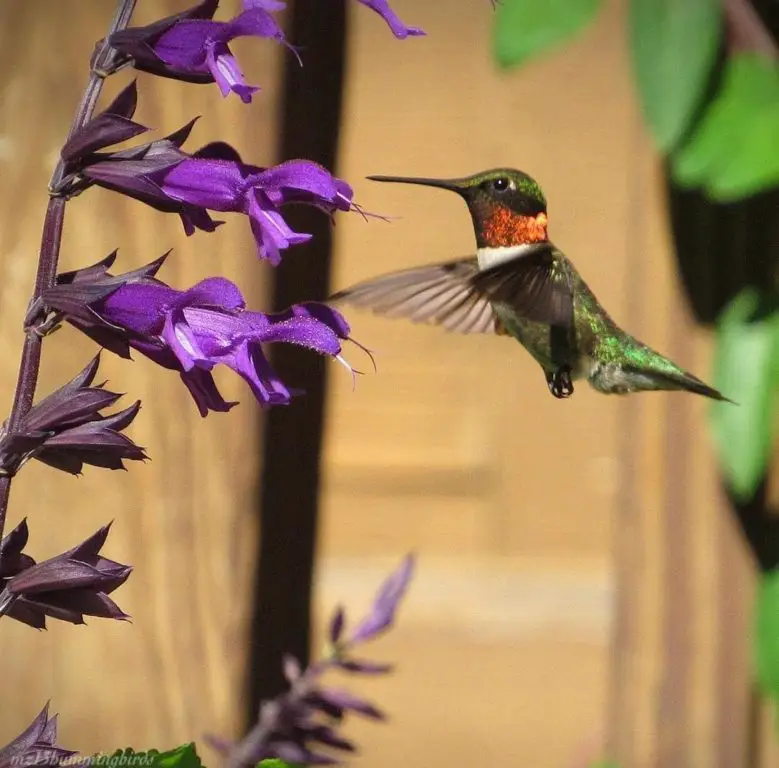
Flower: Friendship Sage – Salvia ‘Amistad’
Backyard Visitors participates in affiliate programs which compensate us for referring traffic.

